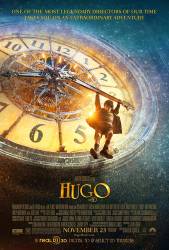Continuity mistake: There is a scene where Hugo is on the station and sees a key down on the tracks. There are two separate shots of the key and both times it is buried in the stones next to a sleeper. Then Hugo jumps down onto the tracks to pick it up and its now sat on the middle of the sleeper when he picks it up. (01:22:30 - 01:23:10)
Continuity mistake: After Frick brings the dog, while Hugo is looking at the inspector, the luggage porter walks behind Hugo twice.
Continuity mistake: The automaton stops making the drawing, right before signing it, and the hand lays by the bottom of a white part of the paper. In the next shot it has magically moved several centimeters above, right on top of the drawing.
Continuity mistake: When the kids are reading the book about cinema, Hugo's right hand appears / disappears randomly next to the book between shots.
Continuity mistake: At the library, Hugo points his finger below Tabard's picture, but when the angle cuts it's on top of it.
Continuity mistake: When Hugo is crouched looking at the two Dachshunds, he is next to a corner, with the dogs on the hall. Yet in the close-up of the dogs, they are against the corner.
Continuity mistake: The amount of ink on the tip of the automaton's pen increases / decreases randomly between shots.
Visible crew/equipment: When Hugo's father is explaining him about the automaton, a screen with letters (very likely a prompter) is reflected on his glasses.
Continuity mistake: After Hugo walks away with Labisse's book, he sees the Inspector and comes to a standstill. When the angle changes, he is repeating the previous movements and coming to a halt again.
Continuity mistake: When Mrs. Méliès is handed the drawing, it swaps from semi-folded to fully opened depending on the angle.
Continuity mistake: Hugo stands by the Méliès' house gates wanting to retrieve the notebook and casts a shadow on the illuminated brick wall. A frame later, when the angle changes, the wall is on the shadows.
Continuity mistake: When Hugo is holding onto the clock's hands, escaping from the inspector, his hand is either right next to a big round bolt, or inches away, depending on the angle.
Continuity mistake: When Hugo's uncle comes in to deliver the bad news he takes the pocket watch and puts it in his pocket. He then takes it again after he stumbles into the clock.
Continuity mistake: When we're first introduced to Méliès, the stuff on the counter keeps changing positions in every single angle.
Continuity mistake: When the kids turn the automaton on, the inkpot swaps from laying part on the table and part on the paper, or totally on the paper, depending on the angle.
Continuity mistake: The first time the dog tries to bite Frick, its nose is pointing in an 8 o'clock direction; then in the close-up, a frame later, it points at 9 o' clock, then it swaps to the first angle and goes back to the original 8 o' clock position.
Continuity mistake: After the automaton re-starts to finish the drawing, Hugo's hair swaps styles 2 or 3 times, most noticeably at the end of the scene, when it goes from messy to brushed.
Continuity mistake: The first time the dog tries to bite Frick, the lady scolds the dog and grabs him. Her hand swaps from laying around its body to covering its head, between shots.
Continuity mistake: In the Library scene where the two kids are examining the old film buffs book, the book is first opened to a page with a bookmark, but the next scene the bookmark is gone.
Revealing mistake: When the kids see the moon picture on the book, an old, chubby hand lays on the page, obviously not the kids'. When the angle changes, their small thin hands re-appear.





